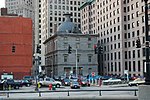Waterplace Park
Geography of Providence, Rhode IslandProtected areas of Providence County, Rhode IslandProvidence, Rhode Island stubsRhode Island geography stubsTourist attractions in Providence, Rhode Island

Waterplace Park is an urban park situated along the Woonasquatucket River in downtown Providence, Rhode Island at the original site of the Great Salt Cove. Finished in 1994, Waterplace Park is connected to 3/4 mile of cobblestone-paved pedestrian walkways along the waterfront known as Riverwalk. Venice-styled Pedestrian bridges cross the river. Most of Riverwalk is below street level and automotive traffic. Waterplace Park and Riverwalk together are host to Providence's popular summertime Waterfire events, a series of bonfires lit on the river accompanied by classical and world music.
Excerpt from the Wikipedia article Waterplace Park (License: CC BY-SA 3.0, Authors, Images).Waterplace Park
Riverwalk, Providence
Geographical coordinates (GPS) Address Nearby Places Show on map
Geographical coordinates (GPS)
| Latitude | Longitude |
|---|---|
| N 41.8237113 ° | E -71.4075563 ° |
Address
Riverwalk
Riverwalk
02903 Providence
Rhode Island, United States
Open on Google Maps











